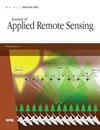Accuracy evaluation of reflectance, normalized difference vegetation index, and normalized difference water index using corrected unmanned aerial vehicle multispectral images by bidirectional reflectance distribution function and solar irradiance
IF 1.4
4区 地球科学
Q4 ENVIRONMENTAL SCIENCES
引用次数: 0
Abstract
In precision agriculture, vegetation and soil are monitored by multispectral sensors that can observe outside the visible bands. In contrast to satellites and manned aircraft, unmanned aerial vehicles (UAVs) allow anyone to easily acquire near-real time data at a reasonable price. However, UAV images do not account for the anisotropic reflectance and solar irradiance from the ground surface, so extracting the reflectance of vegetation is difficult. To solve this problem, this study developed a bidirectional reflectance distribution function (BRDF) that expresses the anisotropic reflectance of the Earth’s surface as a function of the geometric relationship with the UAV sensor and the Sun. To compensate for the effect of changes in solar incident energy due to clouds and solar irradiance, the solar irradiance was measured and corrected on the ground rather than in the air to avoid errors due to the flight attitude. Before processing by the BRDF and correcting for the solar irradiance, the UAV obtained striated orthomosaic images for which the vegetation indices were affected by the position and attitude of the Sun and the UAV sensor. After the correction, consistent values were calculated for the vegetation indices throughout the images. The accuracy of the UAV data was analyzed by comparison with Sentinel 2A. Reflectance differences are 0.02% to 6.37% from the image without correction. After applying the correction, it reduced to 0.27%, 0.61%, 0.16%, and 0.65% from the blue, green, red, and near-infrared bands, respectively. This study is valuable for obtaining accurate values for vegetation indices under a wide range of weather and geometric conditions at different sites because UAVs to collect images are a rare case under optimal conditions.基于双向反射率分布函数和太阳辐照度的校正无人机多光谱影像反射率、归一化植被指数和归一化水体指数精度评价
在精准农业中,植被和土壤由多光谱传感器监测,这些传感器可以观测到可见光波段以外的区域。与卫星和有人驾驶飞机相比,无人驾驶飞行器(uav)允许任何人以合理的价格轻松获取近实时数据。然而,无人机图像没有考虑地表的各向异性反射率和太阳辐照度,因此提取植被反射率是困难的。为了解决这一问题,本研究开发了一个双向反射率分布函数(BRDF),该函数表示地球表面的各向异性反射率与无人机传感器和太阳的几何关系的函数。为了补偿云层和太阳辐照度对太阳入射能量变化的影响,在地面而不是在空中测量和校正太阳辐照度,以避免由于飞行姿态造成误差。在进行BRDF处理和太阳辐照度校正之前,无人机得到植被指数受太阳位置姿态和无人机传感器影响的条纹正射影像。校正后,计算出整幅影像植被指数的一致值。通过与哨兵2A的比较,分析了无人机数据的精度。与未经校正的图像相比,反射率差为0.02% ~ 6.37%。经过校正后,在蓝、绿、红、近红外波段分别降至0.27%、0.61%、0.16%、0.65%。由于无人机在最佳条件下采集图像的情况很少,因此该研究对于在不同地点广泛的天气和几何条件下获得准确的植被指数值具有重要价值。
本文章由计算机程序翻译,如有差异,请以英文原文为准。
求助全文
约1分钟内获得全文
求助全文
来源期刊

Journal of Applied Remote Sensing
环境科学-成像科学与照相技术
CiteScore
3.40
自引率
11.80%
发文量
194
审稿时长
3 months
期刊介绍:
The Journal of Applied Remote Sensing is a peer-reviewed journal that optimizes the communication of concepts, information, and progress among the remote sensing community.
 求助内容:
求助内容: 应助结果提醒方式:
应助结果提醒方式:


